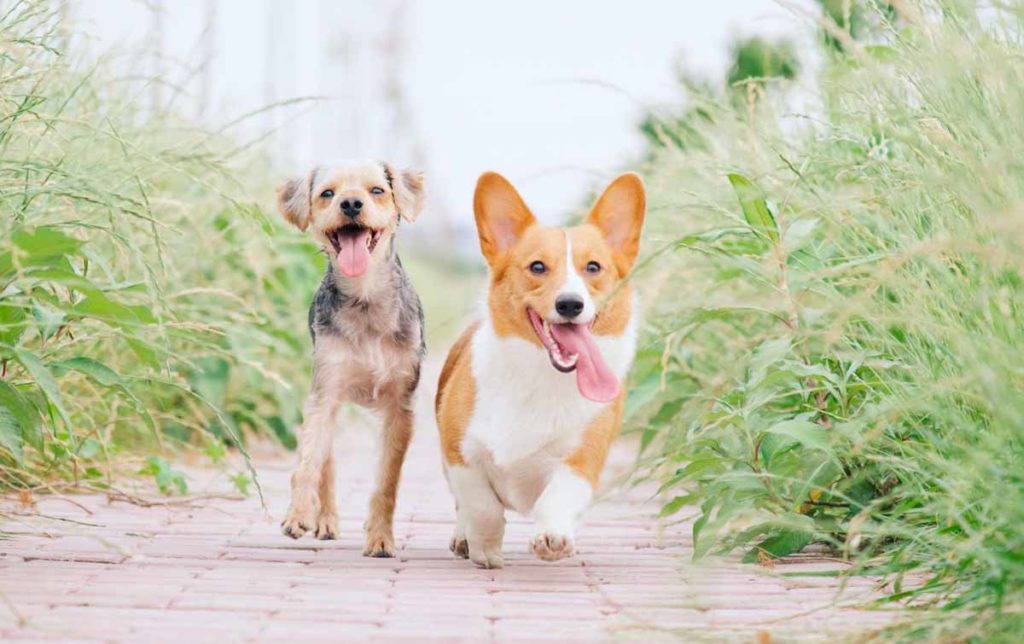Bringing a new puppy into your home is an exciting time, but it is not without its challenges, especially if you have an older dog at home. Most dogs can eventually acclimate peacefully to the new multi-dog dynamic. Here are some steps you can take to ease the transition and create a harmonious home for both you and your dogs.
Swap Scents
The human members of the household may be well aware that a new puppy will be coming, but the canine contingent is not as aware. If possible, try to get a cloth with the new puppy’s scent on it. A dog’s sense of smell is from 10,000 to 100,000 times as acute as a human’s; for dogs, this is a powerful tool for getting to know other dogs, so the presence of the scent in the home before your puppies’ arrival can be helpful.
Prepare Your House
The best way to prevent conflict between your dog and the new puppy is to eliminate the source. Resource guarding occurs in dogs with varying degrees of severity; a few common culprits for territorial behavior include:
- Food / Treats
- Toys
- Crate Space – be sure to create spaces in your home where the dogs can get away from each other, and be prepared to purchase a separate crate for your new family member.
A note about resource guarding: this likely isn’t a result of dominance or jealousy. Just as a 35-year-old does not compete with an infant to pay the bills or be in charge of your household, your dog probably is not competing with the new puppy for dominance. Instead, it’s generally a sign of insecurity, and it is best to use rewards to counter-condition your dog’s response.
Meet in a Neutral Area
Your older dog considers your house his house; to prevent territorial aggression, have your dogs meet in a neutral area. Both dogs must be leashed with independent handlers. Don’t hold the leash too tight, though, as dogs can sense this tension and may get stressed. If there is an issue, move the dogs away from the confrontation.
Take Parallel Walks
Take your dog and new puppy on a walk side-by-side. Walks are effective for enhancing familiarity between your canines, here’s why:
- Guided walks can reduce tension, anxiety, and fear in dogs.
- They help your dog and new puppy establish familiarity with other dogs in a natural canine social behavior.
- The dogs will be distracted by the sights and sounds of their surroundings, minimizing the risk of conflict between them.
Here are some tips for the walk
- Be sure that they are on separate leashes, with two different people holding each leash
- Switch whether the puppy or the dog is leading the walk, and make sure to have them walk right next to each other
- Allow them to sniff each other, but keep the focus in the walk rather than each other
- Don’t hold them too tight, such that they feel restricted
- Keep the pets moving, especially if they seem uncertain
- Make sure your puppy does not walk places where there could be unvaccinated dogs until they are vaccinated!
Use a Howdy Crate
This is a term that zookeepers use when introducing a new animal into an exhibit with other animals for the first time. By putting the new animal in the exhibit, the animals can all say, “Howdy!” to one another through the safety of the crate walls. This will allow your older dog to spend some time getting to know your puppy, with the safety of a physical barrier.
Monitor their Interactions Within the Home
Eventually, you should let both animals interact within the home without physical barriers. Make sure to monitor their interactions, though, as the new puppy may have high energy, which can lead to an off-balance dynamic between your older dog and the new puppy. If you cannot monitor their initial interactions, it is best to keep the two separate.
Watch your dog’s body language to see how they react to each other. Your new puppy may not understand and will engage in playtime even if the older dog is showing signs of discomfort. Body language signs to look out for include:
- Raised fur
- Prolonged Stares
- Growling and Snarling
- Display of Teeth
If there seems to be conflict, intervene. Sometimes, it is effective and natural to allow your older dog to communicate with your puppy as if to say: “Hey kid, we don’t do that.” Don’t allow this to go too far, though, as we cannot trust that our dogs are natural childcare providers.
Play Training Games
It can be effective to run your dogs through a series of simple cues and tricks with both dogs to get them acclimated to each other. Both dogs will be preoccupied, with intermittent sniffs and greets. Be cautious of food-based aggression if you are giving treats, though, and if you notice either dog getting tense, end the game.
More Notes on Getting Off on the Right Paw
Reward your dog if he displays positive behavior and body language with your new pup, such as blinking or softening his ears. Reward both dogs when they share sleeping spaces, swap toys, or disengage from tense situations. It may be hard to recognize, but when a dog deescalates a tense situation, by walking away, reward them.
Over time, the two dogs will get used to the new multi-dog household. Over the adjustment period, be sure to monitor their interactions and give them space separate from each other. Remember to spend quality time with your dog and continue to cherish one-on-one time with both dogs.
The ElleVet Team
844-673-7287
[email protected]
-
 ElleVet Hemp CBD + CBDA Soft Chews$83.99 – $93.99 — or subscribe and save 15%
ElleVet Hemp CBD + CBDA Soft Chews$83.99 – $93.99 — or subscribe and save 15% -
 ElleVet Hemp CBD + CBDA Soft Gels$43.99 – $146.99 — or subscribe and save 15%
ElleVet Hemp CBD + CBDA Soft Gels$43.99 – $146.99 — or subscribe and save 15% -
 ElleVet Hemp CBD + CBDA Oil For Dogs$73.99 – $241.99 — or subscribe and save 15%
ElleVet Hemp CBD + CBDA Oil For Dogs$73.99 – $241.99 — or subscribe and save 15%









